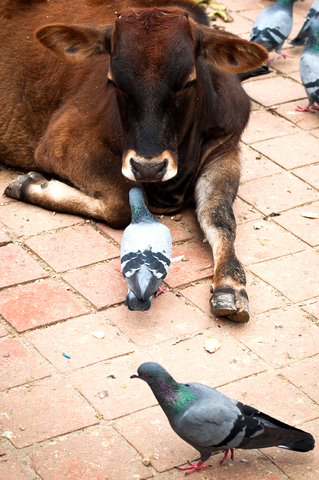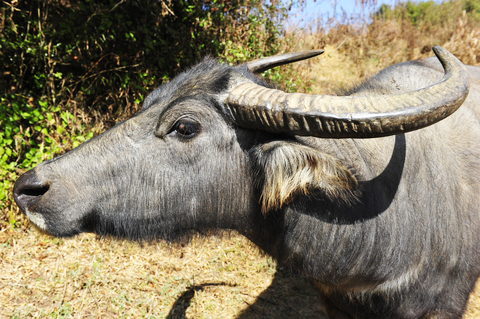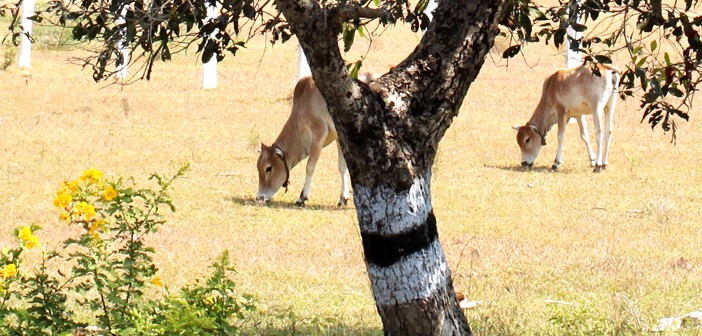Nearly 300 years ago, Bhagwan Chowdhary, a Nepalese man who’d been thrown into prison, prayed to the goddess Gadhimai for help, promising to sacrifice animals to her if she would get him out of jail. He was freed and, in return, he sacrificed five animals to the goddess, and he founded the temple dedicated to her. Today, in the twenty-first century, his great-great-great grandson serves as the head priest. Over the years the animal sacrifices grew and grew until the Gadhimai Temple became known as the world’s most ghastly scene of bloodshed.
On July 28, 2015, at a New Delhi press conference organized by the Animal Welfare Network Nepal, Humane Society International, and People for Animals, the temple authorities of Gadhimai Temple made the announcement that the sacrifice of hundreds of thousands of animals, held every five years, would be permanently canceled. The world’s largest animal sacrifice had finally come to an end.
 Although billions of animals are killed worldwide every year, and no words can do justice to their suffering, the five-year sacrifice at Gadhimai was particularly horrifying. It was visible, taking place outside in full view. In 2009, around 500,000 animals were killed out in the open by men with machetes, resulting in a grotesque scene of unimaginable gore and bloodshed.
Although billions of animals are killed worldwide every year, and no words can do justice to their suffering, the five-year sacrifice at Gadhimai was particularly horrifying. It was visible, taking place outside in full view. In 2009, around 500,000 animals were killed out in the open by men with machetes, resulting in a grotesque scene of unimaginable gore and bloodshed.
That this sacrifice, which drew hundreds of thousands of devotees, could be canceled had seemed impossible – despite all the determined efforts of animal advocates. This tremendous victory will save millions of animals in the future from a horrible death.
In a statement at the press conference, Shri Ram Chandra Shah, the Temple Trust Chairman said, “For every life taken, our heart is heavy…the time has come to replace killing and violence with peaceful worship and celebration.”
 With the support of Humane Society International (HSI), Animal Welfare Network Nepal (AWWN) had for some time been meeting with the temple committee, to work towards ending the sacrifices. The temple committee thanked these groups for showing them a path forward.
With the support of Humane Society International (HSI), Animal Welfare Network Nepal (AWWN) had for some time been meeting with the temple committee, to work towards ending the sacrifices. The temple committee thanked these groups for showing them a path forward.
Gauri Maulekhi, HSI – India consultant and Trustee, People for Animals, remarked on the need for continuing to educate the public, saying, “HSI – India will now spend the next three and a half years till the next Gadhimai educating devotees in the states of Bihar, Jharkhand, Uttar Pradesh, and West Bengal on the temple trust’s decision not to sacrifice animals.”
The Gadhimai Temple Committee has also decided not to sacrifice any animals during the upcoming harvest festival. Instead, they are placing any animals that arrive into a shelter where they’ll be cared for and turned over to animal groups to be rehomed.
 In India, which has a long tradition, over thousands of years, of kindness and reverence towards animals, animal sacrifice is illegal. Occasional incidents of animal sacrifice do still occur in rural villages, never performed by Brahman priests, but only by individual farmers or by local village priests. Animal sacrifice is not part of Hinduism and is denounced by all Indian Hindu authorities.
In India, which has a long tradition, over thousands of years, of kindness and reverence towards animals, animal sacrifice is illegal. Occasional incidents of animal sacrifice do still occur in rural villages, never performed by Brahman priests, but only by individual farmers or by local village priests. Animal sacrifice is not part of Hinduism and is denounced by all Indian Hindu authorities.
However the situation in Nepal is different. Animal sacrifice is widespread. The temple in Nepal that has never practiced animal sacrifice is the Pashupathi Nath Temple founded by the Indian Hindu saint, Adi Sankara, in the seventh century AD. AWWN and many other Nepalese opponents of animal sacrifice have worked for many years to end this gruesome practice.
Awareness of the horrors of Gadhimai and fierce opposition from animal groups has grown worldwide in recent years. A great many individuals and organizations played a part in this victory for animals. Swami Agniyesh, a popular social and animal activist, urged his followers to boycott the festival and held a hunger strike at the Gadhimai Temple.
Back in 1999, Mr. T. Shantilal Jain, then Treasurer of Blue Cross of India, raised the issue of the Gadhimai sacrifice to the Board Members of Blue Cross, asking what might be done to stop it. Dr. Chinny Krishna and Dr. Nanditha Krishna traveled to Nepal, where a prominent businessman had promised to arrange a meeting with then King Birendra. They waited in Kathmandu for three days, however the meeting did not materialize, and they left.
The sacrifices in 2004 and 2009 went ahead. The numbers of animals and people involved only increased – until the numbers of animals sacrificed reached half a million in 2009. They included buffalos, chickens, pigeons, calves, goats, rats, and many others. In recent decades the numbers have exploded, with the majority of the animals coming across the border from India. Many of the animals were brought by small farmers who believed that sacrificing an animal would bring good fortune to their families. Other animals were paid for and transported in trucks.
In 2014, as the time for another five-year sacrifice neared, efforts to halt the bloodshed were stepped up. HSI India persuaded the Chief Priest at Gadhimai to attend the FIAPO (Federation of Indian Animal Protection Organisations) Conference held that year in Jaipur. While he was there many people spoke with him, asking him to cancel the slaughter, including Manoj Gautam, Founder of AWWN, Dr. Nanditha Krishna, Chair of HSI India, and Jayasimha Nuggehalli, Managing Director of HSI India. Mrs. Maneka Gandhi, India Government Minister and Founder of People for Animals, offered financial assistance to re-build the Gadhimai Temple if the sacrifice was halted. Mrs. Gandhi also generously paid the fares of animal activists who traveled by train to Nepal.
Continued in part two…
© Sharon St Joan, 2015
Top photo: © Sharon St Joan
Second photo: © Lakhesis / Dreamstime.com
Third photo: © Yulia Babkina / Dreamstime.com
Fourth photo: © Jdanne / Dreamstime.com





